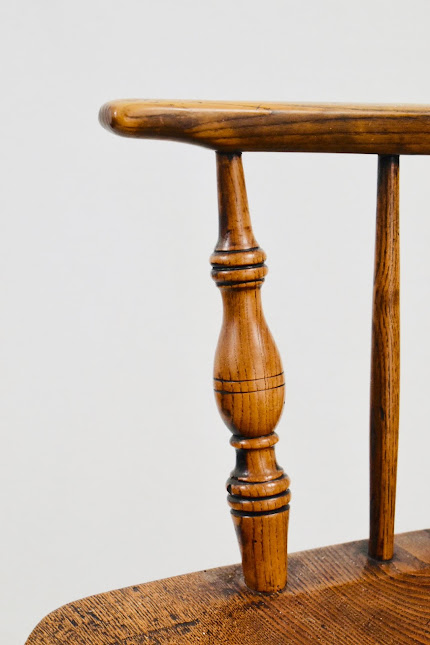This chair turned up in a south Lincolnshire auction in October 2020: even were it not stamped 'MARSH', there are several features which point to Thomas Marsh and his son James. That linked post, which has more biographical details about Thomas (1777 or 1779-1844) and James (1803 - 1870) shows a stamped side chair with the 6 bobbin stretcher. Marsh is the only workshop stamp that has been found with such a stretcher.  |
| Lincolnshire bow back stick back Windsor armchair, 8 long sticks, 6 short, turned underarm supports, straight seat sides, ring and cove turned front legs with lower ring, H stretcher with 6 round bobbins, stamped MARSH, from workshop of MARSH SLEAFORD; 3/4 view |
The small chamfer at the end of the terminals of the arm bow is another characteristic Marsh workshop feature. The circular scribe line just visible on the side stretchers to mark the junction point with the cross stretchers is another Marsh workshop habit.
Another Marsh workshop practice was to pin some of the long sticks with small square wooden pins from the rear of the bows: this chair has two such pins to secure 2nd and 7th long sticks to the back bow, 3 sets of holes for two more, missing the pins, on the 3rd and 6th long sticks (1st at the top in the back bow, 2nd in the arm bow and 3rd in the seat), two more, still with pins, to secure the back bow to the arm bow, and finally 4 more holes, two in the back bow and two in the seat, which appear to have been drilled in the wrong place as they do not align with any of the long sticks, unlike their companions. A momentary lapse of concentration on a Friday afternoon, perhaps.
The top part of each letter of 'MARSH' is just visible at the back of the seat. There does not appear to be any sign of the 'SLEAFORD' stamp that appears on some Marsh chairs. A pair of side chairs, one of which was exhibited at the exhibition in Alford in 2019 has 'MARSH' stamped on one seat and 'SLEAFORD' on the other. All parts of this chair are of ash.
© Julian Parker 2021




















